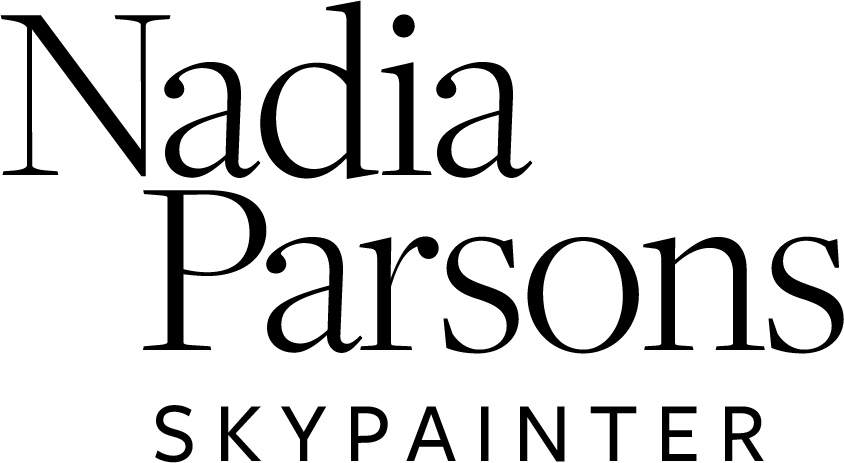Press
Artscope Jan/Feb 2023
An investigation of color and light
Parsons' Sky Paintings open door for SoWa visitors
Sky Painter, Nadia Parsons, has been an artist from a young age. When her mother recognized her dyslexia, she introduced her daughter to creating art, hoping that it was a place where she would flourish. Parsons immediately took to painting and her high school and college years brought her to explore drawing, acting, photography and printmaking. After college, she returned to her childhood passion for painting, working with acrylics when her children were born (they dried faster), and after taking workshops at Massachusetts College of Art and the Museum School at the Museum of Fine Arts, Boston, finally returning to oils to paint the sky.
In 2019, Parsons found a home in the SoWa Art district, where she works and displays her dynamic paintings of skyscapes and connects with visitors to her studio. "I’ve really loved it," she said, "I get to talk about the art with people, I get to encourage people in their artwork." She will take a visitor on a guided tour of her paintings, describing her process, and pointing out themes and details that become clearer and clearer with her passionate explanations.
Why the sky? "There is some excitement and some energy, or sorrow, there’s usually an emotion or a gloriousness about it," Parsons said.
Her process is a journey, sometimes literally, as she will even pull off the Mass Turnpike to photograph a collection of clouds or lighting that resonates with her. Then, she takes the photograph to her studio and explores the image. "I have developed a process that I feel pretty comfortable with where I paint a couple different paintings from the picture," Parsons explained. "I’ll take lots of pictures, but will use one main structure of the picture. Then, I have been veering off into the details because I am really interested in the details." She paints these skyscapes on varied sizes of canvas, board and oil paper, each absorbing the paint and the colors a different way.
Choosing different sizes and surfaces gives Parsons the freedom to explore an image further. Many of her paintings are connected, different parts of a greater whole. After using a photograph to create a painting, she sometimes sets it aside, using the colors remaining or her palette, and creates the image again for memory. "There’s a challenge to it. I have one painting that I started multiple times and it doesn’t work, I can have such strong reactions to my paintings. You are not the way I want you to be! One painting, I had to put the photograph away completely, turn the painting upside down, and paint what I saw in it, push and pull things out."
When she first started painting skies, Parsons experimented with the different hues of gray that she found in the clouds that gathered before a storm. She was fascinated by the colors, and the beams of light that glimmer through, creating new colors and dimensions in the foreboding clouds. The result of this expiration is shown in "Falling icicles I," a stormy swirl of jagged gray forms, evoking an image of a frozen cave with hanging icicles. One of the incredible aspects of Parsons' approach is how abstract and illusory these skyscapes can be, cloud formations and the strips of light shining through can look like mountains, volcanoes and creatures, but all of them simply her expert portrayal of these striking aerial forms.
The evolution of her sky paintings portrays her experimentation with more and more color, the vibrant reds of "Sky 461" are intense, almost fantastical. When speaking about her use of color, Parsons explained, "What part do I want to be intense, and what part do I want to be softer? If everything's intense, it’s all coming at you at once, you have no place to rest and flow round. So, the color does become the composition." Taking inspiration from artists such as J. M. W. Turner, Parsons has become quite adept at using color to present movement and dimension in her works.
Another way that Parsons challenges herself is seen in "Tinted Channels of Mist I," part of a series of skyscapes where she experimented with bringing the darker hues closer to the foreground and the brighter colors behind. She said that the difficult part of this approach is avoiding flatness and creating depth, which she does quite effectively. Viewers are drawn into layers of indigo, lighter blues and pinks — evidence of a marvelous aerial vista, embellished by the artist's investigation of colors and light.
Nadia Parsons' paintings of clouds, celestial bodies and horizons are extraordinary, and each one has the capability to instill an emotional reaction in the viewer. When asked what she wants visitors to her studio to take from experiencing her work, she responded, "The universality of us all looking at the sky and appreciating the earth and our environment. The value of it to humanity. People come here from all over the world and say, 'that looks just like my home!' I feel like that’s part of our humanity. Not to be a cliché but we need that now." The catch, the Artist reminds us, is that we can’t stop looking, "we have to look to see." Visitors to her SoWa studio will leave the building, immediately lift their eyes up to the sky and be reminded that there is beauty above us every single day and thankful to Parsons for this reminder.
Parsons' work is displayed in her studio in the SoWa Artist Guild building, 450 Harrison Ave, Studio 316B, in Boston SoWa District as well as the Intercontinental Hotel in Boston. To see more of her work visit SkyPainterStudio.com
Rachel Flood Page

